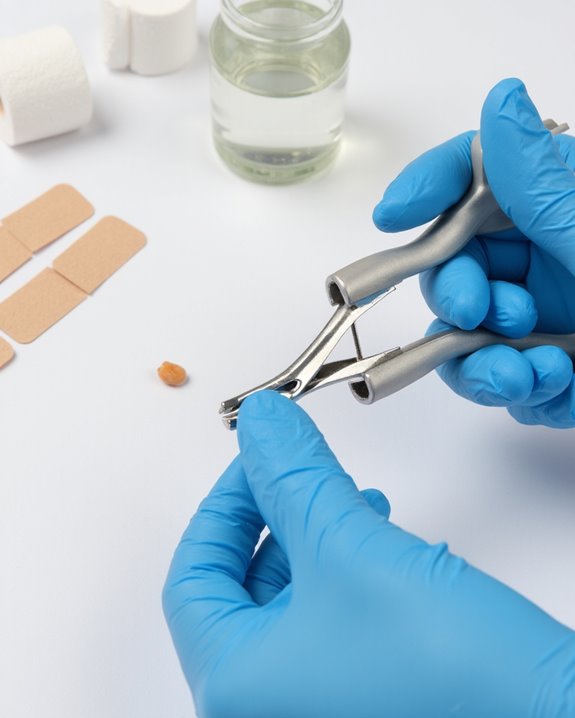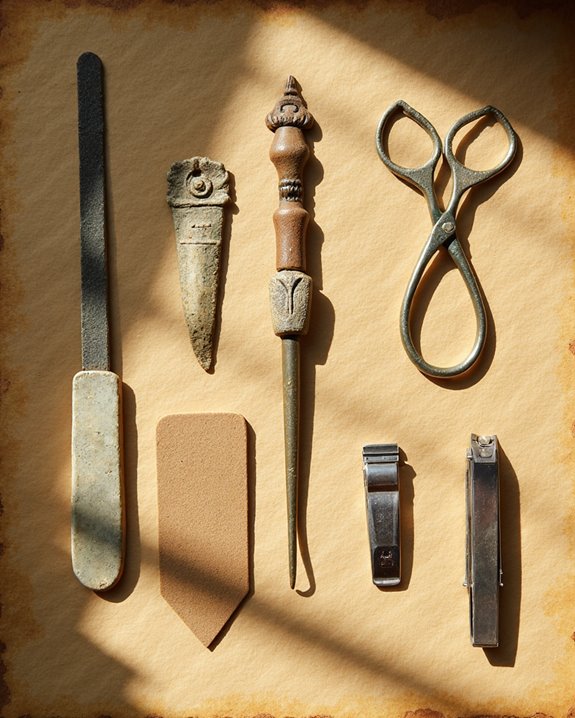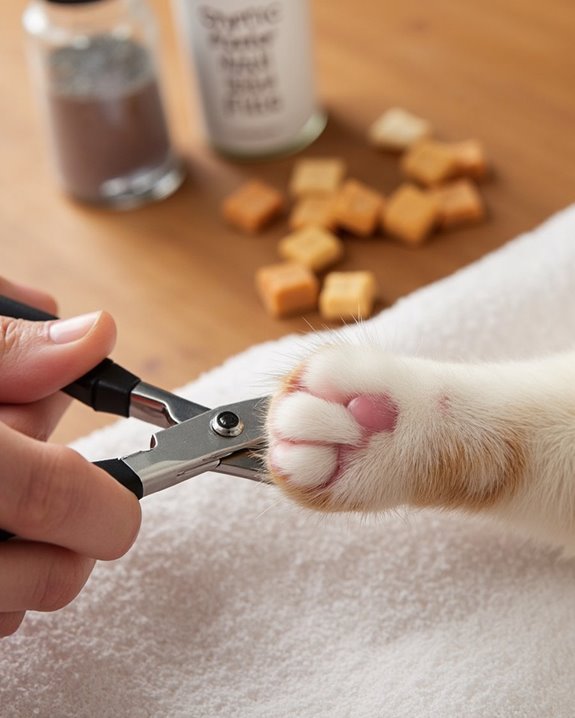Proper nail clipping requires selecting appropriate clippers—curved for fingers, straight for toes. Disinfect tools with rubbing alcohol before use. Trim nails after bathing when softened, holding clippers perpendicular to the nail. Cut fingernails in a slight curve following natural shape, while keeping toenails straight across to prevent ingrown issues. File in one direction to smooth edges, then clean and disinfect clippers after use. Establishing a regular maintenance schedule secures ongoing nail health and prevents complications.
Key Takeaways
- Choose appropriate clippers – fingernail clippers for fingers (curved edge) and toenail clippers for toes (straight edge).
- Disinfect clippers with rubbing alcohol before and after each use to prevent bacterial infections.
- Trim nails after bathing when they’re soft, cutting fingernails in a curved shape and toenails straight across.
- Make several small cuts rather than one large cut, working from side to center to prevent splitting.
- File in one direction after trimming to smooth rough edges and prevent snags or tears.
Choosing the Right Nail Clippers for the Job
Selecting appropriate nail clippers is essential for maintaining healthy nails and preventing potential damage during trimming. For best results, users should differentiate between fingernail clippers and toenail clippers based on their distinct cutting edges and intended purposes. Fingernail clippers feature a smaller size with a rounded shape that matches the natural curve of fingernails, guaranteeing precise, gentle cuts without damage. Toenail clippers, conversely, provide a larger, straight cutting edge specifically designed for thicker nails. High-quality nail clippers, typically crafted from stainless steel, deliver clean cuts that prevent tearing or crushing, which commonly occurs with inferior tools. Best practices include reserving each clipper type for its intended use, as using toenail clippers on fingernails often results in uneven trimming and potential nail damage. Sharp blades greatly reduce effort and guarantee accurate results. Using durable, corrosion-resistant material quality tools ensures longevity and consistent performance over time.
Preparing Your Nails and Tools for Clipping
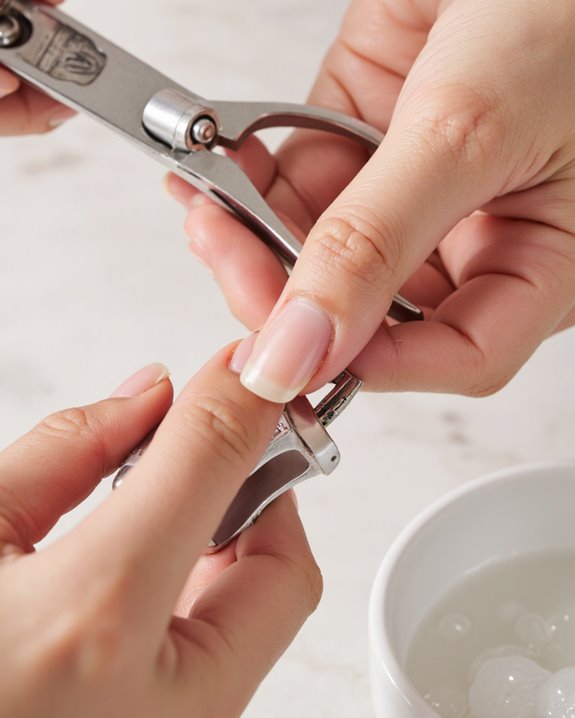
Proper preparation of both nails and tools represents a critical first step in achieving a safe, hygienic, and effective nail-trimming experience. Before beginning, users should disinfect their clippers by thoroughly rinsing them in rubbing alcohol, eliminating bacteria that could potentially cause infections. The essential tools for the job include separate clippers designed specifically for fingernails and toenails, ensuring appropriate sizing and functionality for each purpose.
Timing plays a significant role in preparation, as clipping after bathing when nails are softened reduces splitting risks. Users should carefully assess desired nail length before proceeding, ensuring they maintain some white edge to prevent cutting into sensitive skin beneath. When ready to begin, hold the clippers aligned with the natural curve of each nail, positioning them at the proper angle for a clean, even cut.
Proper Hand Positioning and Grip Techniques
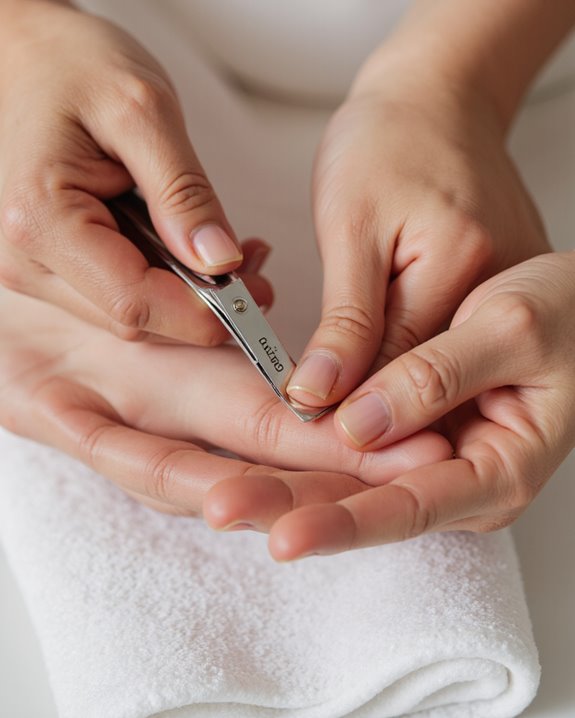
With preparation complete, achieving best nail trimming results hinges on mastering the nail clipper grip. Holding nail clippers is essential for preventing injuries and ensuring clean cuts. Users should position their dominant hand with thumb and index finger firmly on the handles, maintaining control while avoiding excessive pressure that could damage the tool. Proper blade sharpness is crucial for smooth, precise cuts and to prevent nail damage. The proper nail clipper alignment requires positioning the tool perpendicular to the nail, making sure the cutting edge meets the nail at a right angle. As individuals cut their nails, they should pay attention to supporting the finger or toe with their non-dominant hand, which creates stability during the nail trimming process. When opening the clippers, users should operate the lever with gentle but decisive movements, allowing for precise control throughout the cutting action.
Trimming Fingernails With the Correct Angle
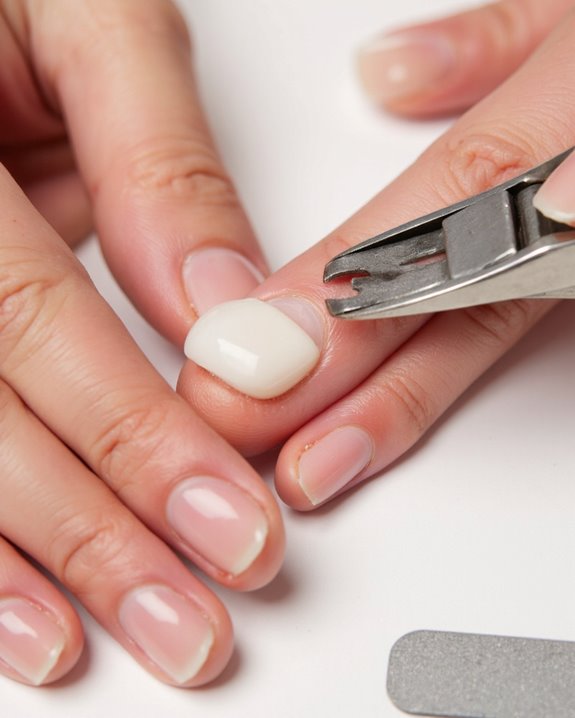
The correct angle makes all the difference when trimming fingernails, creating a neat appearance while preventing painful snags and tears. Standard techniques recommend making several small cuts at a slight angle, mirroring the natural curve of the cuticle along the free edge of the nail. For ideal nail health, position the clippers to follow the fingertip’s contour, maintaining a small white portion at the edge.
When performing nail clipping, experts suggest working in one direction from the side toward the center, which prevents splitting along the edge of the nail. Begin with either the pinky or thumb and methodically work across each finger, adjusting the angle consistently for each nail. This approach avoids cutting straight across, instead following the nail’s natural curve to trim your nails properly, promoting healthy nails and reducing the risk of damage.
Clipping Toenails to Prevent Ingrown Issues
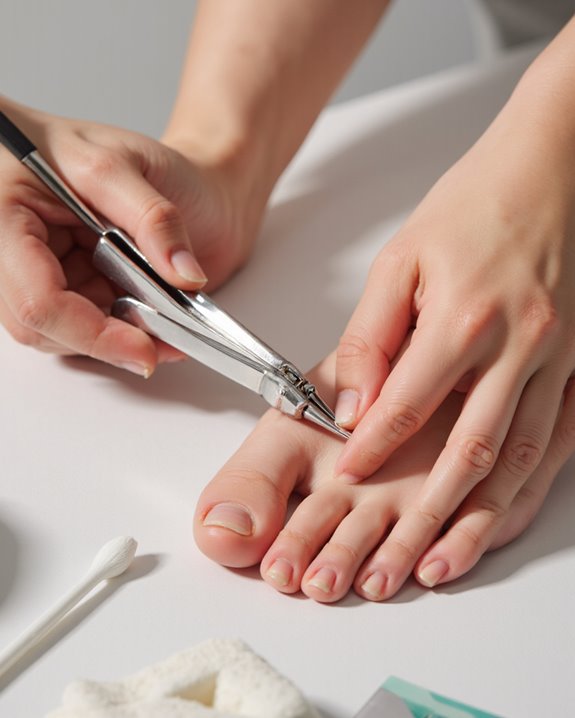
While fingernail care focuses on creating a curved appearance, toenail maintenance requires a fundamentally different approach to prevent painful complications. To guarantee ideal nail health, individuals should select larger clippers specifically designed for toenails, which handle the thicker structure more effectively. Properly trimmed nails should be cut straight across, just beyond where the nail meets the skin, following the natural contour without rounding the edges to reduce the risk of painful ingrown toenails developing.
A systematic technique begins with the big toe, proceeding methodically to smaller toes to maintain consistency. The corners of toenails should never be cut too short, as this practice often leads to the nail growing into the surrounding skin, causing inflammation and irritation. Using Nail Clippers Effectively for toenails means prioritizing straight cuts that prevent nail edges from curling inward.
Filing and Smoothing After Clipping
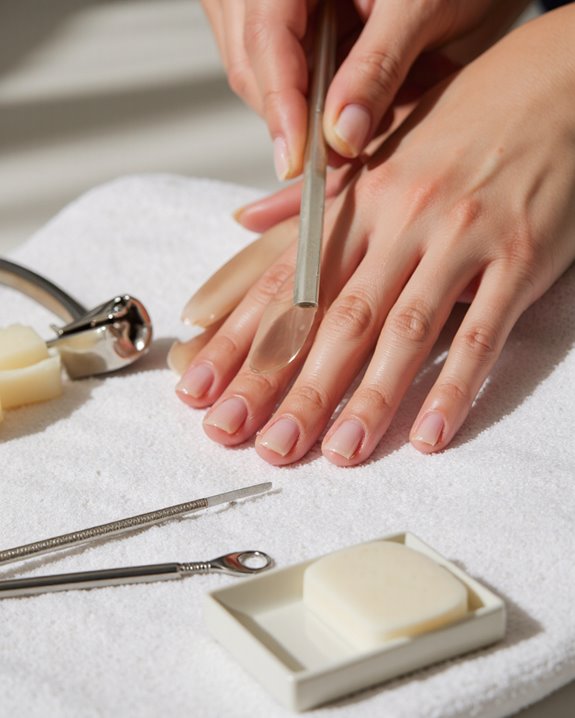
Filing nails properly after trimming represents an essential step that many individuals overlook, despite its critical role in maintaining ideal nail health and appearance. After clipping, experts recommend using a nail file or emery board to gently smooth the edges in one direction, following the natural contour of the nail. This methodical nail filing technique prevents rough, jagged edges that could snag on fabrics, leading to splits or tears in the nail structure. Using the appropriate nail file grit is crucial to avoid damage and ensure a smooth finish. Skipping this vital step increases the risk of bacterial accumulation along uneven surfaces, potentially compromising both aesthetic appearance and hygienic standards. The filing process eliminates microscopic imperfections that might otherwise harbor microorganisms, ensuring nails remain clean and healthy. Professionals emphasize that proper filing completes the trimming process, creating a smooth finish that maintains structural integrity while reducing the likelihood of future nail complications.
Cleaning and Disinfecting Your Nail Clippers
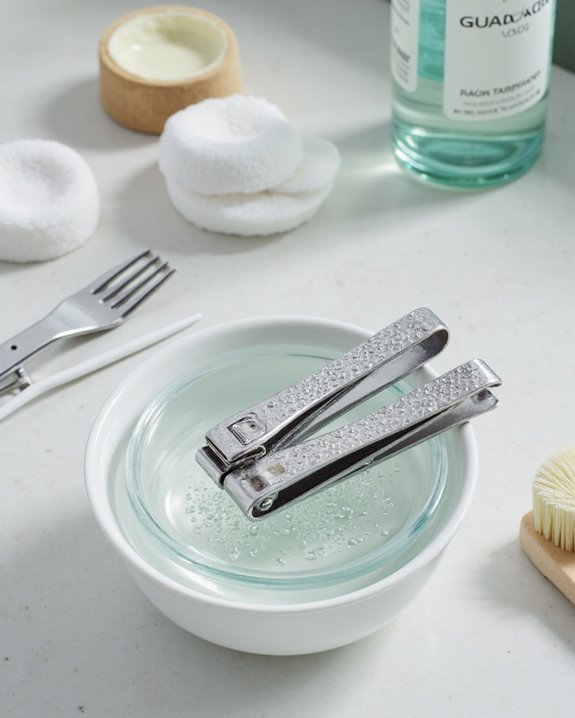
Maintaining proper hygiene for nail grooming tools represents one of the most frequently overlooked aspects of nail care, yet it remains essential for preventing potential infections and securing long-term nail health. After each use, users should wipe the blades with a dry cloth to remove nail clippings, effectively reducing the spread of bacteria and maintaining cleanliness of the tool. For thorough disinfection, rubbing alcohol serves as an ideal solution, as it eliminates germs when applied to the clipper blades through rinsing or brief soaking.
When alcohol is unavailable, an antiseptic solution provides a suitable alternative for keeping tools clean and precise. Gently scrub any visible residue and guarantee complete drying afterward, as moisture creates environments conducive to fungal growth, potentially leading to serious nail problems with continued use of contaminated equipment.
Establishing a Regular Nail Maintenance Schedule
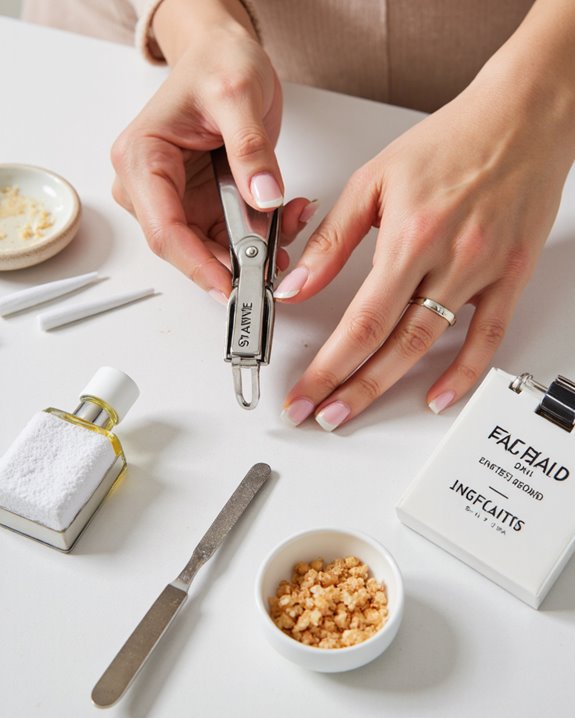
Consistently following a structured nail care routine represents the cornerstone of maintaining healthy, attractive nails throughout one’s lifetime. Experts recommend creating a schedule where individuals trim their nails every 2-4 weeks, which helps maintain appropriate length while preventing breakage and splits. Clippers typically work best when nails are clean and slightly softened, making post-shower maintenance ideal for many people.
Keeping your nails in ideal condition requires daily cleaning beneath the nail bed with soap and water, plus gentle filing in one direction after each trimming session. A thorough maintenance plan should include regular inspection for dirt or damage, particularly after outdoor activities or manual labor. Additionally, proper care involves disinfecting nail clippers with rubbing alcohol after each use, supporting overall hygiene and maintaining healthy and beautiful nails long-term.
Addressing Common Nail Clipping Challenges
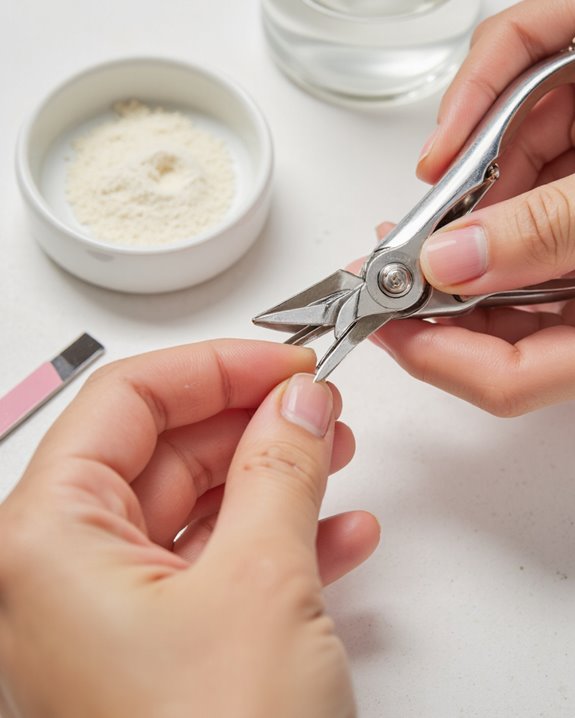
Even experienced individuals encounter several persistent challenges when trimming their nails, despite following best practices for nail maintenance. Clipping your nails too short exposes the sensitive nail bed, which increases infection risk; always leave a small white edge, starting with the shortest nail as a guide. To protect your nails from snagging, file in one direction after trimming, preventing splits and chips from rough edges.
A step-by-step guide to avoid common problems includes: cutting fingernails at a slight angle mirroring the cuticle’s curve while keeping toenails straight across, disinfecting clippers with rubbing alcohol after each use to maintain hygiene, and maintaining a firm grip during the process. This thorough approach reduces the risk of ingrown nails, bacterial infections, and uneven cuts, promoting overall nail health.
Nail Care Tips for Healthy, Strong Nails

The foundation of healthy, strong nails extends beyond proper clipping techniques to include thorough maintenance practices that promote resilience and natural beauty. Regular trimming every few weeks supports how each nail grows, preventing breakage that can compromise overall health. Filing in one direction from one side rather than sawing back and forth helps keep your nails smooth and reduces splitting risks. Daily cleaning underneath nails with soap and water removes debris that can increase the risk of infections, while using separate sanitized tools for fingers and toes prevents cross-contamination. Avoiding excessive shortening during trimming protects the sensitive nail bed, maintaining the natural barrier that contributes to healthy and beautiful nails. These systematic care habits collectively support nail integrity and appearance with minimal effort.
Frequently Asked Questions
How to Use Nail Clippers Correctly?
Proper clippers maintenance guarantees ideal safety precautions. User techniques include selecting appropriate design features for finger versus toenails, employing directional cutting methods, and using material choices that resist corrosion. Proper storage methods prevent damage.
How to Cut Nails Step by Step?
Proper nail cutting involves hygiene practices like sterilizing tools, following length guidelines that leave slight white edges, using smoothing methods afterward, and implementing prevention tips. Routine scheduling of care routines prevents overgrowth and complications.
How to Use Nail Nipper Step by Step?
To use a nail nipper effectively, maintain proper grip techniques while positioning the curved blade precisely. Practice nipper safety by ensuring tool hygiene through regular blade sharpening. After use, implement appropriate storage methods to preserve functionality.
Is It Better to Clip Toenails Wet or Dry?
Clipping toenails when wet offers significant advantages. Moisture effects include softened nails for easier trimming, while dry clipping presents disadvantages like brittleness. Proper hydration impact promotes toenail health, making post-shower the ideal clipping timing.



